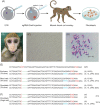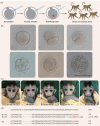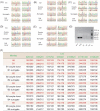Cloning of a gene-edited macaque monkey by somatic cell nuclear transfer
- PMID: 34691835
- PMCID: PMC8291622
- DOI: 10.1093/nsr/nwz003
Cloning of a gene-edited macaque monkey by somatic cell nuclear transfer
Abstract
Cloning of macaque monkeys by somatic cell nucleus transfer (SCNT) allows the generation of monkeys with uniform genetic backgrounds that are useful for the development of non-human primate models of human diseases. Here, we report the feasibility of this approach by SCNT of fibroblasts from a macaque monkey (Macaca fascicularis), in which a core circadian transcription factor BMAL1 was knocked out by clustered regularly interspaced short palindromic repeat/Cas9 gene editing (see accompanying paper). Out of 325 SCNT embryos transferred into 65 surrogate monkeys, we cloned five macaque monkeys with BMAL1 mutations in both alleles without mosaicism, with nuclear genes identical to that of the fibroblast donor monkey. Further peripheral blood mRNA analysis confirmed the complete absence of the wild-type BMAL1 transcript. This study demonstrates that the SCNT approach could be used to generate cloned monkeys from fibroblasts of a young adult monkeys and paves the way for the development of macaque monkey disease models with uniform genetic backgrounds.
Keywords: CRISPR/Cas9 gene editing; circadian rhythm disorders; macaque monkey cloning; non-human primate models; somatic cell nuclear transfer.
© The Author(s) 2019. Published by Oxford University Press on behalf of China Science Publishing & Media Ltd.
Figures



Comment in
-
Editor's notes.Natl Sci Rev. 2019 Jan;6(1):109. doi: 10.1093/nsr/nwz011. Epub 2019 Jan 24. Natl Sci Rev. 2019. PMID: 34694302 Free PMC article. No abstract available.
Similar articles
-
Cloning of Macaque Monkeys by Somatic Cell Nuclear Transfer.Cell. 2018 Feb 8;172(4):881-887.e7. doi: 10.1016/j.cell.2018.01.020. Epub 2018 Feb 1. Cell. 2018. PMID: 29395327
-
Production of MSTN Gene-Edited Embryos of Buffalo Using the CRISPR/Cas9 System and SCNT.Cell Reprogram. 2023 Jun;25(3):121-127. doi: 10.1089/cell.2023.0003. Epub 2023 Apr 11. Cell Reprogram. 2023. PMID: 37042654
-
BMAL1 knockout macaque monkeys display reduced sleep and psychiatric disorders.Natl Sci Rev. 2019 Jan;6(1):87-100. doi: 10.1093/nsr/nwz002. Epub 2019 Jan 24. Natl Sci Rev. 2019. PMID: 34691834 Free PMC article.
-
Clustered Regularly Interspaced Short Palindromic Repeats/Cas9 Gene Editing Technique in Xenotransplantation.Front Immunol. 2018 Sep 5;9:1711. doi: 10.3389/fimmu.2018.01711. eCollection 2018. Front Immunol. 2018. PMID: 30233563 Free PMC article. Review.
-
Livestock Gene Editing by One-step Embryo Manipulation.J Equine Vet Sci. 2020 Jun;89:103025. doi: 10.1016/j.jevs.2020.103025. Epub 2020 Apr 13. J Equine Vet Sci. 2020. PMID: 32563448 Review.
Cited by
-
Embryo-Engineered Nonhuman Primate Models: Progress and Gap to Translational Medicine.Research (Wash D C). 2021 Aug 21;2021:9898769. doi: 10.34133/2021/9898769. eCollection 2021. Research (Wash D C). 2021. PMID: 34549187 Free PMC article. Review.
-
Genetically modified non-human primate models for research on neurodegenerative diseases.Zool Res. 2024 Mar 18;45(2):263-274. doi: 10.24272/j.issn.2095-8137.2023.197. Zool Res. 2024. PMID: 38287907 Free PMC article. Review.
-
Ten Points to Improve Reproducibility and Translation of Animal Research.Front Behav Neurosci. 2022 Apr 21;16:869511. doi: 10.3389/fnbeh.2022.869511. eCollection 2022. Front Behav Neurosci. 2022. PMID: 35530730 Free PMC article.
-
Gene editing in monogenic autism spectrum disorder: animal models and gene therapies.Front Mol Neurosci. 2022 Dec 14;15:1043018. doi: 10.3389/fnmol.2022.1043018. eCollection 2022. Front Mol Neurosci. 2022. PMID: 36590912 Free PMC article. Review.
-
Transgenic rhesus monkeys carrying the human MCPH1 gene copies show human-like neoteny of brain development.Natl Sci Rev. 2019 May;6(3):480-493. doi: 10.1093/nsr/nwz043. Epub 2019 Mar 27. Natl Sci Rev. 2019. PMID: 34691896 Free PMC article.
References
-
- Liu Z, Li X, Zhang JTet al. . Autism-like behaviours and germline transmission in transgenic monkeys overexpressing MeCP2. Nature 2016; 530: 98–102. - PubMed
-
- Niu Y, Shen B, Cui Yet al. . Generation of gene-modified cynomolgus monkey via Cas9/RNA-mediated gene targeting in one-cell embryos. Cell 2014; 156: 836–43. - PubMed
LinkOut - more resources
Full Text Sources
